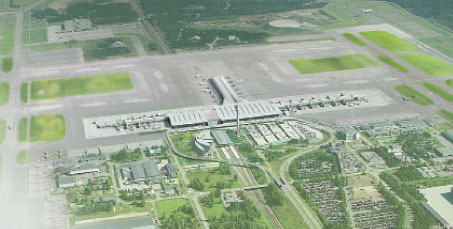
The existing terminal covers an area of 148,000sqm, but upon completion of the project this will rise by a further 117,000sqm, taking the capacity of the integrated facility to 28 million annual passengers.
Construction work on the terminal extension – which has been branded T2 – started in April and it is expected to continue until the spring of 2017, at which point the airport’s capacity and facilities will be significantly enhanced.
At present, the existing terminal covers an area of 148,000sqm, but upon completion of the project this will rise by a further 117,000sqm, taking the capacity of the integrated facility to 28 million annual passengers.
“The airport was built for 17 million passengers and this year we expect 20.5 to 21 million passengers,” Nilsen explained. “The addition of the new terminal with the new space will be very positive for the airport and our passengers. Our prognosis is based on an average increase in passengers of 3.5% per year, but this year we think it will be higher than that. We expect by 2016 that Oslo Airport will handle 23 million, maybe even 24 million passengers.”
Every element of the project is designed to enhance the ability to process passengers quickly, in order to minimise waiting times and increase passenger comfort in the terminal building.
34 new check-in counters will be added to the existing 64, while 12 new security stations will contribute to the central security search area, which is located in such a way that it will minimise walking times to each of the gates. A number of self-service options will also be offered, while passengers will also be presented with an additional 12,000sqm of retail space beyond security.
The new Pier North will boast aircraft gates for both domestic and international flights, extending north of the existing arrival and departure areas.
Sustainable development
While the primary concern of Oslo Airport is to expand the capacity and provide high-class facilities to its passengers, ensuring that this is achieved in an environmentally efficient manner is also a key requirement.
“The new terminal will be 50% more efficient than the existing terminal,” Nilsen said. “We’ll use a number of innovative techniques. For instance, we get a lot of snow in the winter, so this will be cleared into piles and in the summer months when it has melted, the water will be used to cool the terminal.”
Furthermore, the public transport network will also be subject to investment to ensure that the number of passengers using public transport – the Airport Express Train in particular – to access the airport remains high. The current railway station will also be located centrally between the existing and new facilities to ensure passenger convenience, and the surrounding road network will be improved and simplified to allow easier access for the additional passengers using Norway’s main airport.
Vanderlande Industries installing Oslo T2 BHS
Following the awarding of the contract in 2009, Vanderlande Industries is currently working on a long-term project for the installation of the baggage handling systems in the new Terminal 2 at Oslo Airport, Gardermoen. The new terminal is part of the airport’s growth strategy to increase capacity from around 19 million passengers in 2010 to a planned level of 28 million for the first phase.
This new contract is the latest stage in the long?term relationship between Oslo Airport and Vanderlande Industries. This dates back to the late 1990s when the company installed the first BAGTRAX system (track-based Destination Coded Vehicle system) at Gardemoen’s Terminal 1. Since then Vanderlande has carried out a number of system extensions and upgrades to keep pace with the airport’s growth and to optimise system performance and maintainability.
Vanderlande Industries is currently working closely together with the architect in finalising the building preparations, and the actual installation work is expected to start in 2014. Complicating factors in the new Terminal 2 project are the space constraints at the airport and the need for progressive integration of the new systems with the BHS in the existing Terminal 1, while normal airport operations continue.
As well as handling the installation of the new baggage handling system, Vanderlande Industries is also responsible for Operations & Maintenance. Under the performance-based contract the company has full responsibility for the operational aspects of the BHS, and is committed to delivering a guaranteed operational availability level. The work involves a Vanderlande Industries team maintaining a 24/7 on-site presence at the airport. These O&M tasks have been part of the relationship between Vanderlande and the airport right from the start in 1998, since when the guaranteed performance figures have been consistently exceeded.







